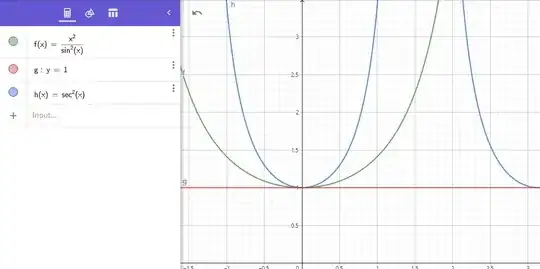I know from L'Hopital's Rule that $$\lim_{t \to 0} \frac{t^2} {\sin^2(t)}=1$$
But I'm also trying to verify this using the Squeeze Theorem.
My first thought is to use the upper and lower bounds of possible outputs (range) of $\sin^2(t)$ as the functions which $\sin^2(t)$ would be between:
$$ 0 \leq \sin^2(t) \leq 1 $$
We want the function in the middle of the inequality to resemble the function we are taking the limit of, so dividing the whole inequality by $t^2$
$$0 \leq \frac{\sin^2(t)}{t^2} \leq \frac{1}{t^2}$$
Then taking the reciprocal of each term
$$0 \geq \frac{t^2}{\sin^2(t)} \geq t^2$$
Now taking the limit of each term of the inequality as $t \to 0$
$$\lim_{t \to 0} 0 \geq \lim_{t \to 0} \frac{t^2}{\sin^2(t)} \geq \lim_{t \to 0} t^2$$
$$ 0 \geq \lim_{t \to 0} \frac{t^2}{\sin^2(t)} \geq 0$$
Thus, by the Squeeze Theorem
$$\lim_{t \to 0} \frac{t^2}{\sin^2(t)} = 0$$
But I know this is incorrect and the limit should evaluate to $1$ just like the answer I got using L'Hopital's Rule. (And this can also be verified looking at the graph of $\frac{t^2}{\sin^2(t)}$ as $t \to 0$).
I'm not sure what step I did incorrectly or perhaps the functions I initially chose as the boundaries are incorrect.
So my questions are how would I evaluate this using the Squeeze Theorem and what part of my thought process is wrong?
